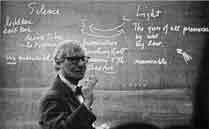January 13, 2006
Color, Pain and Light.

(Image Source)
Pain is a common topic in our household as Stephanie is recuperating from the fall/surgery. The faces scale of pain guide is as good a device as any we've come across. I usually ask: "How do you feel now?" She usually says: "...ok...", verbally corresponding to face scale number two- while her face says number four.
One day, Stephanie described how difficult pain is to gauge: "The pain as I remember it is different from the pain I feel now. I know I felt it worse than it does now but I can't... keep the vividness of that memory. It feels worse now than I remember it did in the beginning." Add to this, the difference between the pain at the initial moment of the accident when the body was scrambling in emergency mode (shock, adrenaline, etc.)... or the differences in well being as day turns to night... or the differences between the pain resulting from a chaos of injuries unleased in the accident (scattered) or the intentionally precise injuries inflicted in the surgery afterward (focused)... the aspects multiply like a hall of mirrors.
I realised that pain was like color. In art, we talk about color theory, but color resists systematizing theory very easily. As a matter of fact, it's more precise to speak of color theories because it is best to consider color wheels and spectrums and any other format we can imagine. For this, I let out a little hurrah. I grew up in the generation where art theory was pretty overbearing. Totalizing. Closed. Bossy. Bad, bad bad, especially for the sake of being able to talk about art, for the sake of theory itself.
Yesterday, stephanie told me that the production people at her workplace are administering a color test to identify people who are at the least color blind, or at the most, finding people who see color differently than most people do. Teh second category seemed funny to her. She said: "Everyone will see a different color, even those with good color sense. Different positions in a room will present a different aspect of color to each person. Each person's perspective will show a different color sense, at least for those wo can see subtle differences in colors in the world."
Slippery stuff, color is.
So color is free and therefore color is cool.
And pain is like color. Pain is slippery.
Can pain be cool too?
(In a benign, constructive, life giving... theoretical way?)
So... what about light?
The other day, we were invited to our neighbor's place for dinner. Paul and Margosha Vangelisti are wonderful neighbors. (Click the link, Paul and Margosha have a rich history and I intend to describe it to you all in another blogpost. Promise.). A fellow dinner guest that night was a gentleman who teaches theater lighting at CalArts (a nice guy, but his name escapes me now). I mentioned my thoughts about pain and color and this gentleman suggested that lighting could be a third category.
Yes of course! Another force unbridled, lighting.
I know nothing about theater lighting design, but I know a little about architecture. I thought of Louis Kahn, one of my favorite architects. Kahn would swoon over the architectural implications of light. "Silence and Light", he called it:
Silence to Light
Light to Silence
The threshold of their crossing
is the Singularity
is Inspiration
(Where the desire to express meets the possible)
is the Sanctuary of Art
is the Treasury of the Shadows
(Material casts shadows shadows belong to light)
My mind reaches for a possible (and admittedly homespun) axiom:
Art exists in places that are hard to pin down.
How about that?
Posted by Dennis at January 13, 2006 8:56 PM

Leave a comment